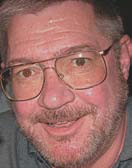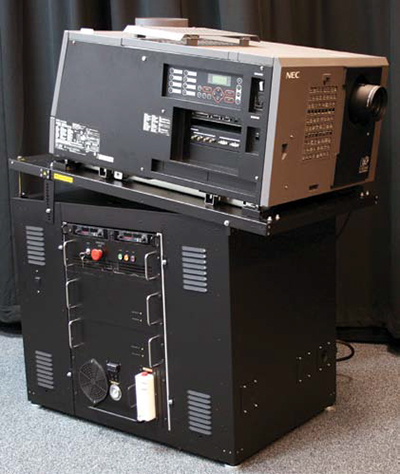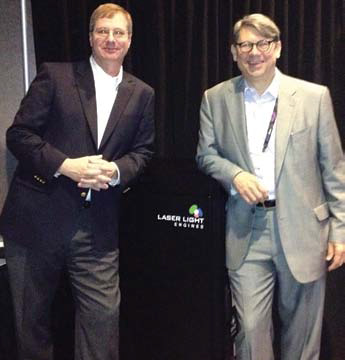Is Laser-Illuminated Projection the Future of 3D?

Jay Ankeney
Last month I saw the future of digital cinema exhibition and the future is bright and beautiful. With the help of NEC Display Solution’s top-of- the-line NC 3240S digital cinema projection systems, Laser Light Engines Inc. staged a week of demonstrations of laser-illuminated theatrical projection at the Technicolor Interop Technology Center in Burbank, Calif. What was seen on the screen was spectacular.
In the booth of the TITC theater were two of NEC’s flagship NC 3240S 4K DLP cinema projectors, one lit by a standard Xenon lamp and the other operating with the latest laser engine from LLE. The demonstration included 2D content on both white and silver screens and 3D content on a silver screen with the laser-powered projector presenting the left eye and the Xenon version beaming the right.
It is important not to call LLE’s modification of the NEC projector “laser projection” since, as will be explained shortly, the light emitted into the theater is not high-powered coherent laser light. Therefore, the technically correct appellation for this technology is “laser illuminated” projection.

This may become significant as this technology is rolled out. After all, based on experiences with unshielded laser light shows dating back to 1960s rock concerts, the FDA still requires operators to apply for a safety variance for each laser-source installation above 5,000 lumens.
HOLLYWOOD INTEREST
Bill Beck, founder and executive vice president of business development for LLE, told me, “Hollywood’s interest in this week of demonstrations has been phenomenal, with representatives from all the studios coming to our sessions. We predict that by the end of the week all the film community will be behind the adoption of laser-illuminated projection.”
As Beck explained, one reason is that the operational costs of laser light sources can be significantly lower than high-powered digital cinema Xenon lamps, which only last about 600 hours at full power with their output dropping to 70 percent in the first few hundred hours and to 50 percent by the end of life. That will make retrofitting digital cinema projectors with laser light engines even for 2D presentations very appealing to theater owners as the technology evolves.
The professional video industry's #1 source for news, trends and product and tech information. Sign up below.

Laser Light Engines RGB systems are delivered in a standalone rack, but can also be configured and installed in typical industry projector pedestals having 16RU or larger capacity. But for 3D fans, the benefit will be finally providing viewers with the 14 foot-lamberts of brightness hitting their eyes, which is the recommended level for optimal 3D imagery. While 14 foot-lamberts is the DCI spec for 2D, it has been very difficult for 3D theaters to achieve this level of illumination, so 3D releases are usually color-timed for the 4–6 foot-lamberts of their real-world exhibition.
Achieving those 14 foot-lamberts (named after 18th century Swiss-German physicist Johann Heinrich Lambert) with cost-effective technology is the key breakthrough with this laser-illuminated projection design. To create left/right separation, a projector’s beam passes through the 3Denabling technology in front of its lens. This can be either left/right polarizing filters, sets of color wavelength filter wheels or alternate frame display systems. These can reduce the brightness hitting a viewer’s eyes by 72–90 percent. That’s why many 3D theaters actually provide their premium ticket-paying customers a dimmed down cinema experience far below the optimum viewing requirements for proper 3D.
According to Paul Panabaker, director of product planning at LLE, in the demonstration we saw at the Technicolor facility the projectors were putting 17.5 foot-lamberts of luminance on the 22-foot screen, which allowed the intended 14 foot-lamberts to reach the viewers’ eyes through the ReadD glasses, which were provided.
MASTERING THE STUMBLING BLOCKS
Laser-illuminated projection has been attempted for 20 years, but until recently one of the major stumbling blocks in its theatrical acceptance has been the problem of “speckle,” which is a shimmering or sparkling artifact caused by microscopic constructive and destructive interference of the light when displaying large expanses of the same color.
“Our solution is to convert the columnated coherent light coming out of the laser engine into conventional light before it emerges from the projector,” explained LLE’s Beck. “This directional brightness is far more efficient than a Xenon lamp, which means the amount of light you can get out of a laser-illuminated projector is not optically limited. Then, to minimize speckle, our patented technology, which widens the color band, lets the RGB light diverge in multiple angles to average the interference patterns generated by the individual beams.”

John O’hara (L), CEO of Laser Light Engines, Inc. and Bill Beck, founder and executive vice president of business development During the TITC 3D demonstration, which included viewing clips from “Gravity,” “The Life of Pi” and “The Last Reef” among other films, all timed at 14 foot-lamberts, I was fortunate to secure a seat directly in the middle of the theater surrounded by some of the best “golden eyes” in the digital cinema business. Many of these experts claimed to still see some speckle artifacts in the movie clips, which my “golden-aged’ vision did not detect except, perhaps when pure color bars were projected, but they were all enthusiastic about laser-illuminated projection’s potential.
“This technology will enable 3D to be seen in a way the public has never been able to before,” said Garrett J. Smith, who was responsible for digital mastering operations at Paramount for more than two decades.
“This has to be the future of 3D because viewers expect the color in 3D presentations to look as true as it does in 2D. The future is laser projection, no doubt about it!” added John A Rupkalvis of StereoScope International.
“I was very impressed by the image brightness,” said John Cox who QCs digital cinema packages for Shutter Ghost. “I’m often bothered by the consistency problems with Xenon lamps when traveling around the studios, and we should see a much greater consistency from laser light engines.
John T. O’Hara, president and CEO of Laser Light Engines, said they expect to start seeing digital cinema projectors retrofitted with laser-illuminated light sources up to about 45,000 lumens in large screen venues starting in Q2 of 2014. With advanced cooling systems, these could soar to 70,000 lumens.
Now the question is whether Hollywood studios will provide prints color-timed for the hallowed grail of 14 foot-lamberts to take full advantage of it.
Jay Ankeney is a freelance editor and post-production consultant based in Los Angeles. Write him atJayAnkeney@mac.com.
